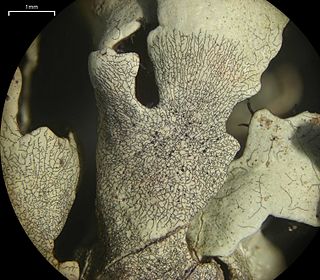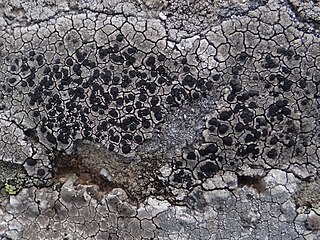
Peltigera scabrosa is a lichen which has a circumpolar distribution. Its common name is scabby pelt.

The Ostropales are an order of fungi in the class Lecanoromycetes. The order was circumscribed by Swedish botanist John Axel Nannfeldt in 1932. The order contains 4 families and 46 genera, including 6 genera of uncertain familial placement.
Norrlinia is a genus of two species of fungi in the family Verrucariaceae. The genus was circumscribed by Ferdinand Theissen and Hans Sydow in 1918. The genus name honours the Finnish botanist Johan Petter Norrlin. Both species are lichenicolous, meaning they parasitise lichens. The host of both fungi is the foliose genus Peltigera.
Cercidospora is a genus of fungi in the class Dothideomycetes. The relationship of this taxon to other taxa within the class is unknown. The genus was first described by Gustav Wilhelm Körber in 1865; it is synonymous with the name Prolisea described by Frederick Edward Clements in 1931.

Phacopsis is a genus of lichenicolous (lichen-dwelling) fungi. They are parasites of members of the large lichen family Parmeliaceae, of which they are also a member. Originally proposed by Edmond Tulasne in 1852 to contain 3 species, Phacopsis now contains 10 species, although historically, 33 taxa have been described in the genus. Many of the species are poorly known, some of them having been documented only from the type specimen.

Lichenostigma cosmopolites is a species of lichenicolous fungus belonging to the family Phaeococcomycetaceae. It was described as new to science in 1999 by lichenologists Josef Hafellner and Vicent Calatayud. The fungus grows parasitically on Xanthoparmelia lichens. In India it has been reported from the thallus of Xanthoparmelia stenophylla.

Muellerella pygmaea is a species of lichenicolous fungus in the family Verrucariaceae. It has a cosmopolitan distribution in Arctic-alpine areas and grows on the thallus and apothecia of a number of hosts.
Xenonectriella subimperspicua is a species of lichenicolous fungus in the family Nectriaceae. It has been recorded from South America, Europe, and New Zealand.
Neoechinodiscus kozhevnikovii is a species of lichenicolous (lichen-eating) fungus in the order Helotiales. It is known to occur in Russia, Austria, and Switzerland, where it grows parasitically on lichens in genus Cetraria.
Cercidospora epipolytropa is a species of lichenicolous fungus in the genus Cercidospora but it has not been assigned to a family. It is known to parasitise the crustose lichen Lecanora polytropa. The fungus was first formally described by mycologist William Mudd in 1861. Ferdinand Christian Gustav Arnold transferred it to Cercidospora in 1874.
Cercidospora thamnoliicola is a species of lichenicolous fungus in the genus Cercidospora but it has not been assigned to a family. It is known to parasitise the lichen Thamnolia vermicularis in Iceland but it is rare there. The species was first formally described by mycologist Per G. Ihlen in 1995, from specimens growing on Thamnolia vermicularis in Norway.
Stereocaulon botryosum is a species of snow lichen belonging to the family Stereocaulaceae.
Stereocaulon depressum is a species of snow lichen belonging to the family Stereocaulaceae.
Stereocaulon rivulorum is a species of snow lichen belonging to the family Stereocaulaceae.
Cercidospora stereocaulorum is a species of lichenicolous fungus in the genus Cercidospora but it has not been assigned to a family. It is known to parasitise lichens of the genus Stereocaulon.

Cladonia pocillum is a species of lichen in the family Cladoniaceae. Swedish botanist Erik Acharius first formally described the species in 1803 as Baeomyces pocillum, but Olivier Jules Richard transferred it to the genus Cladonia in 1877.
Cercidospora soror is a species of lichenicolous fungus in the genus Cercidospora but it has not been assigned to a family. It was discovered growing on Arthrorhaphis citrinella in Austria but has since then also been reported from Greenland, where it infects Arthrorhaphis alpina and Arthrorhaphis citrinella.
Muellerella erratica is a species of lichenicolous fungus in the family Verrucariaceae. It has been reported from numerous countries, including India. Known host species include the thallus of Lecidea lapicida and Lecanora.

Xanthoparmelia stenophylla is a species of foliose lichen in the family Parmeliaceae.

Lecidea lapicida is a species of lichen in the family Lecideaceae. It has a worldwide distribution but it is rare in the tropics.







